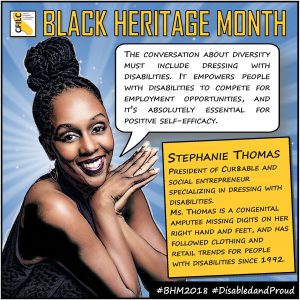Stephanie Thomas, Disability Fashion Stylist

For over 25 years, Stephanie Thomas has researched clothing and retail trends for people with disabilities. What started as a Miss America preliminary pageant platform grew into a hobby, and now two decades later, has morphed into her life’s work. Although there are many adaptive designers around the world (and have been since at least the 1930’s), there are fewer than 10 people in the world with Stephanie’s personal background and experience working exclusively as stylists for people with disabilities.
“I am a congenital amputee missing digits on my right hand and feet, and I’ve followed clothing and retail trends for people with disabilities for 25 years. As a social entrepreneur specializing in dressing with disabilities, I use my Disability Fashion Styling System™ (DFSS) to empower others with disabilities to dress with as much choice, dignity, and self reliance as possible.”
The three guiding principles that Stephanie keeps in mind when styling someone:
- Is it ACCESSIBLE? Easy to put on and take off on your own or with a dresser?
- Is it SMART? Not causing harm to the body; medically safe?
- Is it FASHIONABLE? Fits body type and lifestyle. Loved by the wearer.
Accessibility varies depending on the wearer. For example:
- A person in a seated position (i.e.: a wheelchair user)
- Pants would be designed to sit higher in the back to prevent sagging.
- Pants could also have zippers on both sides from ankle to waist to make it easier for the wearer to dress themselves and/or conceal leg bags or other equipment.
- Pants pockets need zippers, too, to prevent items from falling out.
- Coats and another outerwear pieces that unzip from the back, make it easier for someone to help a high-level quad put on or off.
- A person with a prosthetic limb
- A woman with a prosthetic leg may enjoy a skirt with a fitted waist and an A-line design. It would assist in “balancing someone out” if one hip sat higher than the other. The design of the skirt would serve to provide an illusion of symmetry where needed.
- Keep fabrics lightweight and breathable as prosthetics can make wearers warm.
Watch Stephanie’s Tedx Talk below or by clicking here.
To register for an upcoming Ability Tools Training, click here.




